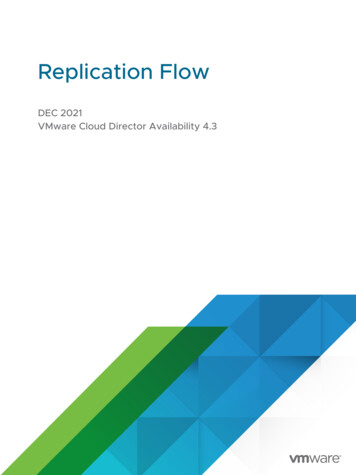
Transcription
UT DALLASErik Jonsson School of Engineering & Computer ScienceData management in the cloud usingHadoopMurat KantarciogluFEARLESS engineering
Outline Hadoop - Basics HDFS– Goals– Architecture– Other functions MapReduce––––BasicsWord Count ExampleHandy toolsFinding shortest path example Related Apache sub-projects (Pig, Hbase,Hive)FEARLESS engineering
Hadoop - Why ? Need to process huge datasets on largeclusters of computers Very expensive to build reliability into eachapplication Nodes fail every day– Failure is expected, rather than exceptional– The number of nodes in a cluster is not constant Need a common infrastructure– Efficient, reliable, easy to use– Open Source, Apache Licence version of GoogleFile SystemFEARLESS engineering
Who uses Hadoop? Amazon/A9 Facebook Google– It has GFS New York TimesVeohYahoo! . many moreCloudera– Similar to Redhat business model.– Added services on HadoopFEARLESS engineering
Commodity HardwareAggregation switchRack switch Typically in 2 level architecture––––Nodes are commodity PCs30-40 nodes/rackUplink from rack is 3-4 gigabitRack-internal is 1 gigabitFEARLESS engineering
UT DALLASErik Jonsson School of Engineering & Computer ScienceHadoop Distributed File System(HDFS)Original Slides byDhruba BorthakurApache Hadoop Project Management CommitteeFEARLESS engineering
Goals of HDFS Very Large Distributed File System– 10K nodes, 100 million files, 10PB– Yahoo is working on a version that can scale to largeamounts of data. Assumes Commodity Hardware– Files are replicated to handle hardware failure– Detect failures and recover from them Optimized for Batch Processing– Data locations exposed so that computations can move towhere data resides Remember moving large data is an important bottleneck.– Provides very high aggregate bandwidthFEARLESS engineering
Distributed File System Single Namespace for entire cluster– Again this is changing soon!!! Data Coherency– Write-once-read-many access model– Client can only append to existing files Files are broken up into blocks– Typically 64MB block size– Each block replicated on multiple DataNodes Intelligent Client– Client can find location of blocks– Client accesses data directly from DataNodeFEARLESS engineering
HDFS ArchitectureFEARLESS engineering
Functions of a NameNode Manages File System Namespace– Maps a file name to a set of blocks– Maps a block to the DataNodes where it resides Cluster Configuration Management Replication Engine for BlocksFEARLESS engineering
NameNode Metadata Metadata in Memory– The entire metadata is in main memory– No demand paging of metadata Types of metadata––––List of filesList of Blocks for each fileList of DataNodes for each blockFile attributes, e.g. creation time, replication factor A Transaction Log– Records file creations, file deletions etcFEARLESS engineering
DataNode A Block Server– Stores data in the local file system (e.g. ext3)– Stores metadata of a block (e.g. CRC)– Serves data and metadata to Clients Block Report– Periodically sends a report of all existing blocks tothe NameNode Facilitates Pipelining of Data– Forwards data to other specified DataNodesFEARLESS engineering
Block Placement Current Strategy––––One replica on local nodeSecond replica on a remote rackThird replica on same remote rackAdditional replicas are randomly placed Clients read from nearest replicasFEARLESS engineering
Heartbeats DataNodes send hearbeat to the NameNode– Once every 3 seconds NameNode uses heartbeats to detectDataNode failureFEARLESS engineering
Replication Engine NameNode detects DataNode failures– Chooses new DataNodes for new replicas– Balances disk usage– Balances communication traffic to DataNodesFEARLESS engineering
Data Correctness Use Checksums to validate data– Use CRC32 File Creation– Client computes checksum per 512 bytes– DataNode stores the checksum File access– Client retrieves the data and checksum fromDataNode– If Validation fails, Client tries other replicasFEARLESS engineering
NameNode Failure A single point of failure Transaction Log stored in multiple directories– A directory on the local file system– A directory on a remote file system (NFS/CIFS) Need to develop a real HA solution– Ongoing work to have multiple NameNodesFEARLESS engineering
Data Pipelining Client retrieves a list of DataNodes on whichto place replicas of a block Client writes block to the first DataNode The first DataNode forwards the data to thenext node in the Pipeline When all replicas are written, the Clientmoves on to write the next block in fileFEARLESS engineering
Rebalancer Goal: % disk full on DataNodes should besimilar– Usually run when new DataNodes are added– Cluster is online when Rebalancer is active– Rebalancer is throttled to avoid networkcongestion– Command line toolFEARLESS engineering
Secondary NameNode Copies FsImage and Transaction Log fromNamenode to a temporary directory Merges FSImage and Transaction Log into anew FSImage in temporary directory Uploads new FSImage to the NameNode– Transaction Log on NameNode is purgedFEARLESS engineering
User Interface Commands for HDFS User:– hadoop dfs -mkdir /foodir– hadoop dfs -cat /foodir/myfile.txt– hadoop dfs -rm /foodir/myfile.txt Commands for HDFS Administrator– hadoop dfsadmin -report– hadoop dfsadmin -decommision datanodename Web Interface– http://host:port/dfshealth.jspFEARLESS engineering
UT DALLASErik Jonsson School of Engineering & Computer ScienceMapReduceOriginal Slides byOwen O’Malley (Yahoo!)&Christophe Bisciglia, Aaron Kimball & Sierra Michells-SlettvetFEARLESS engineering
MapReduce - What? MapReduce is a programming model forefficient distributed computing It works like a Unix pipeline– cat input grep sort uniq -c cat output– Input Map Shuffle & Sort Reduce Output Efficiency from– Streaming through data, reducing seeks– Pipelining A good fit for a lot of applications– Log processing– Web index buildingFEARLESS engineering
MapReduce - DataflowFEARLESS engineering
MapReduce - Features Fine grained Map and Reduce tasks– Improved load balancing– Faster recovery from failed tasks Automatic re-execution on failure– In a large cluster, some nodes are always slow or flaky– Framework re-executes failed tasks Locality optimizations––––With large data, bandwidth to data is a problemMap-Reduce HDFS is a very effective solutionMap-Reduce queries HDFS for locations of input dataMap tasks are scheduled close to the inputs whenpossibleFEARLESS engineering
Word Count Example Mapper– Input: value: lines of text of input– Output: key: word, value: 1 Reducer– Input: key: word, value: set of counts– Output: key: word, value: sum Launching program– Defines this job– Submits job to clusterFEARLESS engineering
Word Count DataflowFEARLESS engineering
Word Count Mapperpublic static class Map extends MapReduceBase implementsMapper LongWritable,Text,Text,IntWritable {private static final IntWritable one new IntWritable(1);private Text word new Text();public static void map(LongWritable key, Text value,OutputCollector Text,IntWritable output, Reporter reporter) throwsIOException {String line value.toString();StringTokenizer new StringTokenizer(line);while(tokenizer.hasNext()) rd,one);}}}FEARLESS engineering
Word Count Reducerpublic static class Reduce extends MapReduceBase implementsReducer Text,IntWritable,Text,IntWritable {public static void reduce(Text key, Iterator IntWritable values,OutputCollector Text,IntWritable output, Reporter reporter) throwsIOException {int sum 0;while(values.hasNext()) {sum values.next().get();}output.collect(key, new IntWritable(sum));}}FEARLESS engineering
Word Count Example Jobs are controlled by configuring JobConfs JobConfs are maps from attribute names to string values The framework defines attributes to control how the job isexecuted– conf.set(“mapred.job.name”, “MyApp”); Applications can add arbitrary values to the JobConf– conf.set(“my.string”, “foo”);– conf.set(“my.integer”, 12); JobConf is available to all tasksFEARLESS engineering
Putting it all together Create a launching program for your application The launching program configures:– The Mapper and Reducer to use– The output key and value types (input types areinferred from the InputFormat)– The locations for your input and output The launching program then submits the job andtypically waits for it to completeFEARLESS engineering
Putting it all togetherJobConf conf new s(conf, new , new Path(args[1]));JobClient.runJob(conf);FEARLESS engineering
Input and Output Formats A Map/Reduce may specify how it’s input is to be readby specifying an InputFormat to be used A Map/Reduce may specify how it’s output is to bewritten by specifying an OutputFormat to be used These default to TextInputFormat andTextOutputFormat, which process line-based text data Another common choice is SequenceFileInputFormatand SequenceFileOutputFormat for binary data These are file-based, but they are not required to beFEARLESS engineering
How many Maps and Reduces Maps– Usually as many as the number of HDFS blocks beingprocessed, this is the default– Else the number of maps can be specified as a hint– The number of maps can also be controlled by specifying theminimum split size– The actual sizes of the map inputs are computed by: max(min(block size,data/#maps), min split size) Reduces– Unless the amount of data being processed is small 0.95*num nodes*mapred.tasktracker.tasks.maximumFEARLESS engineering
Some handy tools PartitionersCombinersCompressionCountersZero ReducesDistributed File CacheToolFEARLESS engineering
Partitioners Partitioners are application code that define how keysare assigned to reduces Default partitioning spreads keys evenly, but randomly– Uses key.hashCode() % num reduces Custom partitioning is often required, for example, toproduce a total order in the output– Should implement Partitioner interface– Set by callingconf.setPartitionerClass(MyPart.class)– To get a total order, sample the map output keys and pickvalues to divide the keys into roughly equal buckets and usethat in your partitionerFEARLESS engineering
Combiners When maps produce many repeated keys––––It is often useful to do a local aggregation following the mapDone by specifying a CombinerGoal is to decrease size of the transient dataCombiners have the same interface as Reduces, and often are thesame class– Combiners must not side effects, because they run an intermdiatenumber of times– In WordCount, conf.setCombinerClass(Reduce.class);FEARLESS engineering
Compression Compressing the outputs and intermediate data will often yieldhuge performance gains– Can be specified via a configuration file or set programmatically– Set mapred.output.compress to true to compress job output– Set mapred.compress.map.output to true to compress map outputs Compression Types (mapred(.map)?.output.compression.type)– “block” - Group of keys and values are compressed together– “record” - Each value is compressed individually– Block compression is almost always best Compression Codecs(mapred(.map)?.output.compression.codec)– Default (zlib) - slower, but more compression– LZO - faster, but less compressionFEARLESS engineering
Counters Often Map/Reduce applications have countable events For example, framework counts records in to and outof Mapper and Reducer To define user counters:static enum Counter {EVENT1, EVENT2};reporter.incrCounter(Counter.EVENT1, 1); Define nice names in a MyClass Counter.propertiesfileCounterGroupName MyCountersEVENT1.name Event 1EVENT2.name Event 2FEARLESS engineering
Zero Reduces Frequently, we only need to run a filter on the inputdata– No sorting or shuffling required by the job– Set the number of reduces to 0– Output from maps will go directly to OutputFormat and diskFEARLESS engineering
Distributed File Cache Sometimes need read-only copies of data on the localcomputer– Downloading 1GB of data for each Mapper is expensive Define list of files you need to download in JobConf Files are downloaded once per computer Add to launching fs://nn:8020/foo”), conf); Add to task:Path[] files DistributedCache.getLocalCacheFiles(conf);FEARLESS engineering
Tool Handle “standard” Hadoop command line options– -conf file - load a configuration file named file– -D prop value - define a single configuration propertyprop Class looks like:public class MyApp extends Configured implements Tool{public static void main(String[] args) throwsException {System.exit(ToolRunner.run(new Configuration(),new MyApp(), args));}public int run(String[] args) throws Exception { . getConf() .}}FEARLESS engineering
Example: Finding the Shortest Path A common graph searchapplication is finding theshortest path from a startnode to one or moretarget nodes Commonly done on asingle machine withDijkstra’s Algorithm Can we use BFS to findthe shortest path viaMapReduce?FEARLESS engineering
Finding the Shortest Path: Intuition We can define the solution to this probleminductively– DistanceTo(startNode) 0– For all nodes n directly reachable from startNode,DistanceTo(n) 1– For all nodes n reachable from some other set of nodesS,DistanceTo(n) 1 min(DistanceTo(m), m S)FEARLESS engineering
From Intuition to Algorithm A map task receives a node n as a key, and(D, points-to) as its value– D is the distance to the node from the start– points-to is a list of nodes reachable from n p points-to, emit (p, D 1) Reduces task gathers possible distances to agiven p and selects the minimum oneFEARLESS engineering
What This Gives Us This MapReduce task can advance the knownfrontier by one hop To perform the whole BFS, a non-MapReducecomponent then feeds the output of this stepback into the MapReduce task for anotheriteration– Problem: Where’d the points-to list go?– Solution: Mapper emits (n, points-to) as wellFEARLESS engineering
Blow-up and Termination This algorithm starts from one node Subsequent iterations include many morenodes of the graph as the frontier advances Does this ever terminate?– Yes! Eventually, routes between nodes will stopbeing discovered and no better distances will befound. When distance is the same, we stop– Mapper should emit (n,D) to ensure that “currentdistance” is carried into the reducerFEARLESS engineering
Extensions to Map-Reduce There are other systems that– Use Distributed file systems– Manage large number of tasks that areinstantiations of user-written functions.– Deal with failures gracefully.– Example from Ullman’s book:FEARLESS engineering
Extensions to Map-Reduce Main applications for Workflow systems– Representing a cascade of multiple-map reduce jobs– Complex distributed tasks Generally more efficient than running multiple mapreduce sequentially.– Writing results to hard disks could be problematic.– Potential pipelining optimizations.FEARLESS engineering
UT DALLASErik Jonsson School of Engineering & Computer ScienceHadoop SubprojectsFEARLESS engineering
Hadoop Related Subprojects Pig– High-level language for data analysis Hbase– Table storage for semi-structured data Zookeeper– Coordinating distributed applications Hive– SQL-like Query language and Metastore Mahout– Machine learningFEARLESS engineering
UT DALLASErik Jonsson School of Engineering & Computer SciencePigOriginal Slides byMatei ZahariaUC Berkeley RAD LabFEARLESS engineering
Pig Started at Yahoo! Research Now runs about 30% of Yahoo!’s jobs Features– Expresses sequences of MapReduce jobs– Data model: nested “bags” of items– Provides relational (SQL) operators(JOIN, GROUP BY, etc.)– Easy to plug in Java functionsFEARLESS engineering
An Example Problem Suppose you haveuser data in a file,website data inanother, and youneed to find the top5 most visited pagesby users aged 18-25Load UsersLoad PagesFilter by ageJoin on nameGroup on urlCount clicksOrder by clicksTake top 5FEARLESS engineering
In MapReduceFEARLESS engineering
In Pig LatinUsers load ‘users’ as (name, age);Filtered filter Users by age 18 and age 25;Pages load ‘pages’ as (user, url);Joined join Filtered by name, Pages by user;Grouped group Joined by url;Summed foreach Grouped generate group,count(Joined) as clicks;Sorted order Summed by clicks desc;Top5 limit Sorted 5;store Top5 into ‘top5sites’;FEARLESS engineering
Ease of TranslationLoad UsersLoad PagesFilter by ageJoin on nameGroup on urlCount clicksOrder by clicksTake top 5FEARLESS engineeringUsers load Fltrd filter Pages load Joined join Grouped group Summed count() Sorted order Top5 limit
Ease of TranslationLoad UsersLoad PagesFilter by ageJoin on nameJob 1Group on urlJob 2Count clicksOrder by clicksJob 3Take top 5FEARLESS engineeringUsers load Fltrd filter Pages load Joined join Grouped group Summed count() Sorted order Top5 limit
UT DALLASErik Jonsson School of Engineering & Computer ScienceHBaseOriginal Slides byTom WhiteLexeme Ltd.FEARLESS engineering
HBase - What? Modeled on Google’s BigtableRow/column storeBillions of rows/millions on columnsColumn-oriented - nulls are freeUntyped - stores byte[]FEARLESS engineering
HBase - Data ModelRowTimestampColumn ESS engineeringanimal:sizet2zebrat1lionbig Columnfamilyrepairs:repairs:cost1000 EUR
HBase - Data StorageColumn family animal:(enclosure1, t2, animal:type)zebra(enclosure1, t1, animal:size)big(enclosure1, t1, animal:type)lionColumn family repairs:(enclosure1, t1, repairs:cost)FEARLESS engineering1000 EUR
HBase - CodeHtable table Text row new Text(“enclosure1”);Text col1 new Text(“animal:type”);Text col2 new Text(“animal:size”);BatchUpdate update new BatchUpdate(row);update.put(col1, “lion”.getBytes(“UTF-8”));update.put(col2, ;update new BatchUpdate(row);update.put(col1, date);FEARLESS engineering
HBase - Querying Retrieve a cellCell :type”).getValue(); Retrieve a rowRowResult table.getRow( “enclosure1” ); Scan through a range of rowsScanner s table.getScanner( new String[] { “animal:type” } );FEARLESS engineering
UT DALLASErik Jonsson School of Engineering & Computer ScienceHiveOriginal Slides byMatei ZahariaUC Berkeley RAD LabFEARLESS engineering
Hive Developed at Facebook Used for majority of Facebook jobs “Relational database” built on Hadoop––––Maintains list of table schemasSQL-like query language (HiveQL)Can call Hadoop Streaming scripts from HiveQLSupports table partitioning, clustering, complexdata types, some optimizationsFEARLESS engineering
Creating a Hive TableCREATE TABLE page views(viewTime INT, userid BIGINT,page url STRING, referrer url STRING,ip STRING COMMENT 'User IP address')COMMENT 'This is the page view table'PARTITIONED BY(dt STRING, country STRING)STORED AS SEQUENCEFILE; Partitioning breaks table into separate files foreach (dt, country) pairEx: /hive/page view/dt 2008-06-08,country USA/hive/page view/dt 2008-06-08,country CAFEARLESS engineering
A Simple Query Find all page views coming from xyz.comon March 31st:SELECT page views.*FROM page viewsWHERE page views.date '2008‐03‐01'AND page views.date '2008‐03‐31'AND page views.referrer url like '%xyz.com'; Hive only reads partition 2008‐03‐01,*instead of scanning entire tableFEARLESS engineering
Aggregation and Joins Count users who visited each page by gender:SELECT pv.page url, u.gender, COUNT(DISTINCT u.id)FROM page views pv JOIN user u ON (pv.userid u.id)GROUP BY pv.page url, u.genderWHERE pv.date '2008‐03‐03'; Sample output:FEARLESS engineering
Using a Hadoop Streaming Mapper ScriptSELECT TRANSFORM(page views.userid,page views.date)USING 'map script.py'AS dt, uid CLUSTER BY dtFROM page views;FEARLESS engineering
Hadoop Murat Kantarcioglu. FEARLESS engineering Outline Hadoop - Basics HDFS - Goals - Architecture - Other functions MapReduce - Basics - Word Count Example - Handy tools - Finding shortest path example Related Apache sub-projects (Pig, Hbase,Hive) FEARLESS











